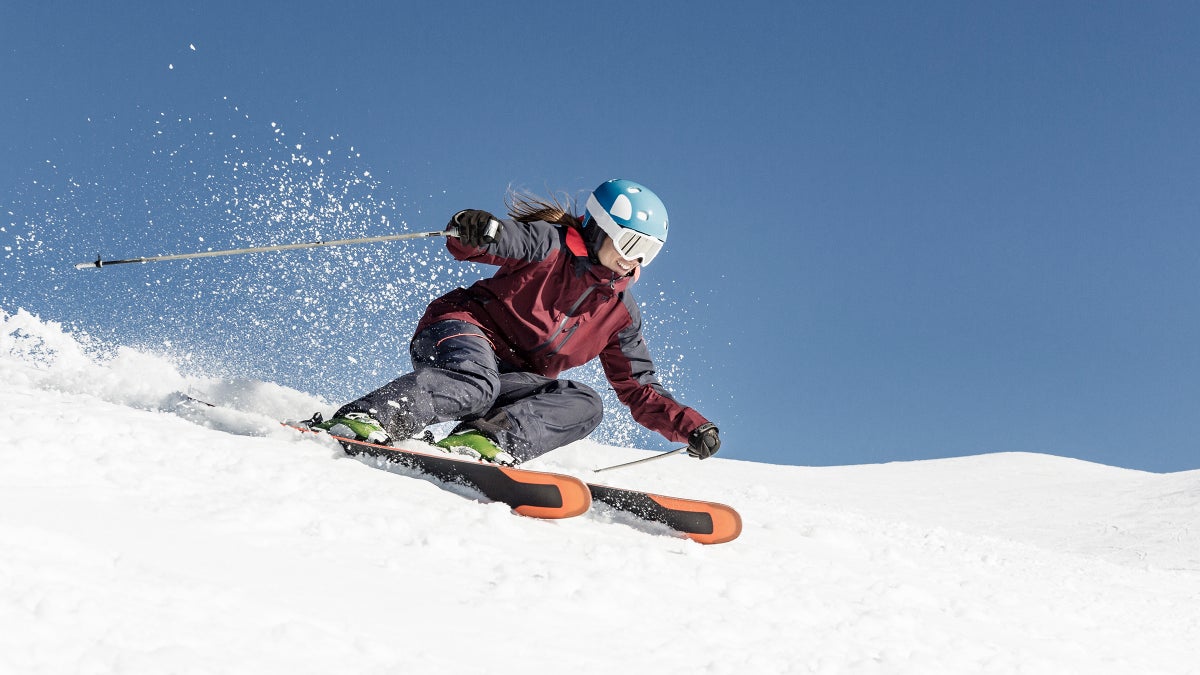No products in the cart.
Outdoor Adventure
Runner Up Review: The Frontside Skis That Almost Made Our 2022 Winter Buyer’s Guide
Do you spend the majority of your time on the hill carving groomers, snaking through bumps, and skiing packed snow off trail? With waist widths in the 86- to 90-millimeter range, all mountain frontside skis are your jam. They’re built for everyday ripping back east, or out west in places that see average snowfall but above average skier traffic like Summit County, Colorado. These skis are for spending 70 percent of your time on trail and 30 percent off trail.
At our annual test we check out more than a dozen of the newest skis in this category. Over the course of three days and thousands of feet of vert, our testers fill out feedback forms to help us identify the very best options. But, in a field this stacked, all of the runners up are fantastic as well. Here’s the full rundown.
Unisex All Mountain Frontside Skis
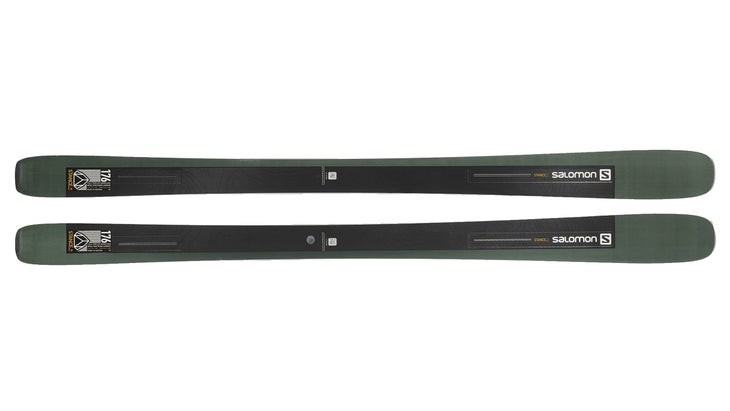
Salomon Stance 90 ($800)
Dimensions: 126/90/108
The Stance 90 delivers off-trail versatility thanks to a full 90 millimeters of width underfoot and just enough rocker to let you easily break through turns. But make no mistake, this is not a loose and lightweight bushwhacker. Two sheets of titanal reinforce a substantial wood core (smart cutouts in the shovels ease the torsional stiffness) while a full sandwich construction with vertical sidewalls adds still more edgehold. The resulting ski was our test director’s top ski of the category, just above the Experience 86 Ti, which won the men’s frontside category this year. “This Stance just rips,” he said. “I like it far more than the Stance 96, which is a bit fat for the amount of carve it offers. The 90 got that balance right.” It’s damp and stable, but super easy to ski—perfect for arcing carved turns 70 percent of the time. On groomers it’s best to just settle into that 18-meter turn radius and hold on.But we wouldn’t hesitate to go ski a chalky chute or some wind-buffed snow up in the alpine.
Gripe: One tester thought it was just a hair too grippy for the category, but incredibly that was the only real critique in the test cards.
Like: “More than confident—cocky,” said a tester. “Stable as hell at top speeds, but executes at a walking pace too.”
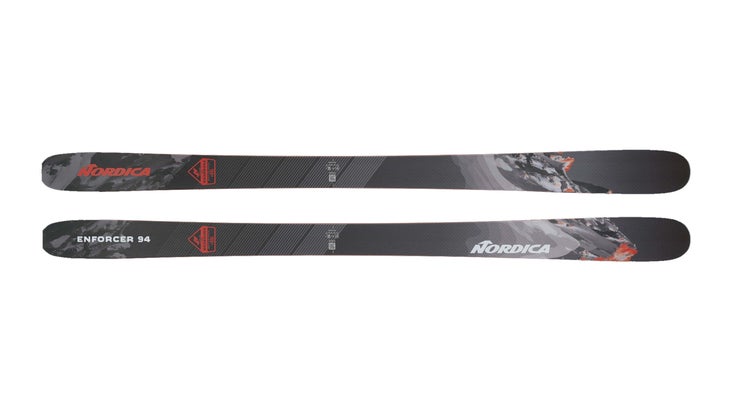
Nordica Enforcer 94 ($800)
Dimensions: 127.5/94/115.5
This year, the all mountain frontside category was stacked. The Enforcer 94, which was new last year, is proof. “If this category was intended for 50/50 on-trail/off-trail skis instead of a 70/30 ratio, the 94 would have won,” said a tester. “The balance of the construction, the flex, the power, and the ease of use make it ready for a huge range of conditions.” This is a no-bullshit ski. Two sheets of metal back a full wood core and vertical sidewalls for edge bite. But the oomph doesn’t end there. Strategically placed carbon fiber—strands, not sheets, run the length of the ski—ups the torsional stiffness without overdoing it, allowing the ski to release energy back to you in transition between turns. In other words, the harder you push it, the more alive it gets. The 94 definitely favors advanced to expert skiers that can bend a ski from tip to tail. But despite the scary name, most of the skis in this family are user friendly and can accommodate a wide range of abilities.
Gripe: You need to really get after it to put the 94s into a short turn. They excel at those 16 to 19-meter radii.
Like: “Smashes everything in sight,” said a tester. “The edge grip is money. Carries speed out of the end of the turn.”
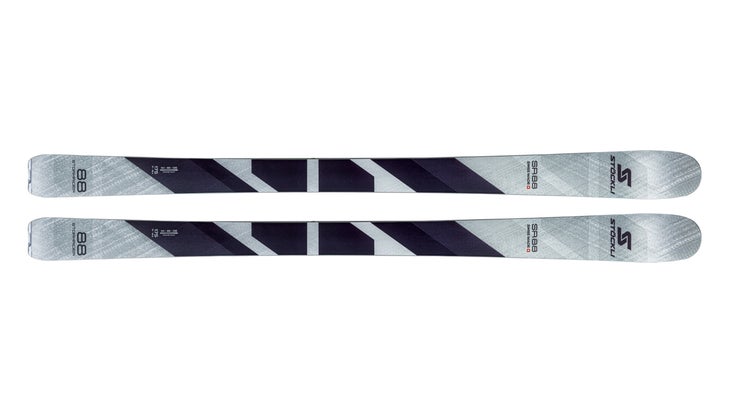
Stöckli Stormrider 88 ($1,049)
Dimensions: 128/88/114
It’s no surprise that the Stormrider 88 finished with such a high ranking, Stöckli builds some of the highest quality skis on the planet. The Swiss builder mills its own wood cores to find the balance between weight savings and durability. In the Stormrider, that balance is bolstered by two layers of special pre-impregnated fiberglass (they don’t just glop the resin on) that weigh 25 percent less than standard fiber. Designers even save grams at the edges by reducing the mass of the part of the metal that inserts into the ski. This allows them to keep two sheets of titanal—one doubles as the top sheet instead of plastic—so they don’t sacrifice stability. The result flexes deeply and is as stable as any in this class. “For what seems like decades, I’ve always loved the feel of the Stormrider line,” said one of our most seasoned testers. “But in keeping with modern ski design, you don’t have to scream at them in Swiss-German to turn anymore.” Most brands now make skis that perform well for a season or two. The Stöcklis price is high because of the stellar craftsmanship and materials, which mean the brand’s skis retain their life for years.
Gripe: Similar to the Enforcer 94, the Stormrider 88 favors medium to large radius arcs.
Like: Unlike the Enforcer 94, it comes to life at slower speeds. “So easy to ski,” said a tester. “The flex is compliant, but they flat-out rip when you push them.”
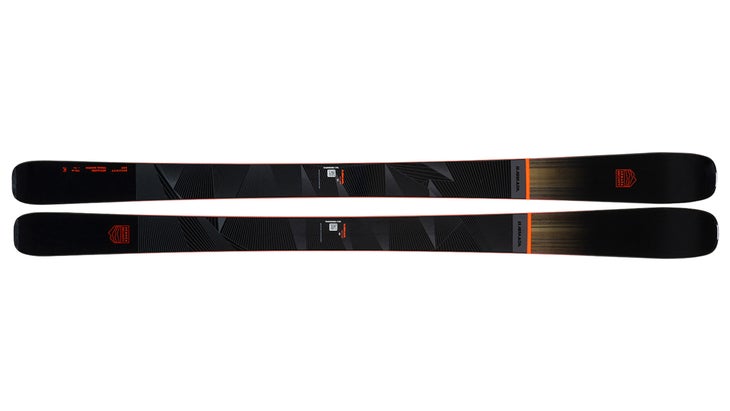
Armada Declivity 88 C ($700)
Dimensions: 131/88/112
The “C” in Declivity 88 C stands for carbon—a tricky material. Add just a touch too much and it will over-juice the torsional rigidity, giving the ski a tenuous and hollow feel. Underplay your hand and you don’t get enough torsion, resulting in a dead ride and insufficient edge bite. Armada got it right. Even on the hard melt/freeze snow we had at last March’s test, the 88 C was a tip-it-and rip-it ski. “Damp and silky ride,” said a tester. “It’s powered up, but it’s fun too. Carves a nice round turn.” Beneath the hood, a caruba wood core saves weight, while stout carbon stringers run tip to tail. But it’s the shaping and balance that makes the 88 C work. The relatively deep rocker, middle-distance sidecut, balanced flex, and torsional rigidity all work together to deliver smooth arcs. At this width, it’s also capable of slinking around off-trail in trees and bumps. So where does it excel? It’s light and nimble and features a fairly tight turn radius, so we’d ski off groomed runs—bumps, steeps, corn—most of the time. But if there’s nothing decent to ski beyond the machined groomed stuff, this Armada is not a liability. It out-skied a half dozen metal skis on piste at Steamboat.
Gripe: We didn’t have much to complain about, but a few testers wanted a bit more zip in transitions.
Like: “Fun and playful for an all-mountain frontside entry,” said a tester. “Surprisingly stable at speed, but it packs a ton of all mountain versatility.”
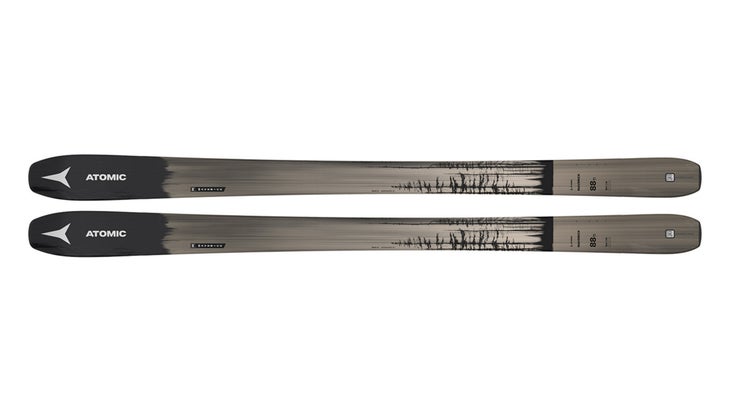
Atomic Maverick 88 Ti ($800)
Dimensions: 124.5/88/109.5
Here’s another 88-millimeter wide ski that isn’t built with just groomers in mind. The Maverick 88 is a true all mountain ski capable of ripping turns on groomers and off piste in soft but not deep conditions. “Super easy to carve, but nimble and fun off-trail too,” said a tester. But take that comment with some more context. It came from one of our bigger testers who might have been overflexing the Maverick. A few of our lighter skiers thought it was more of a burly on-piste tool. (Choose your length carefully.) At 1,800 grams per ski with two sheets of metal, there’s a ton of versatility baked in. It’s light enough to shoulder for a hike and pivot around off-trail, but it will carve a big arc on groomers, too.
Gripe: The Maverick 88s need to be broken in before they ski their best. Our test skis weren’t, which might be why a few testers found it hard to settle into the sweet spot of the flex.
Like: “Super powerful in a big sweeper turn,” said a tester. “The energy return is robust.”
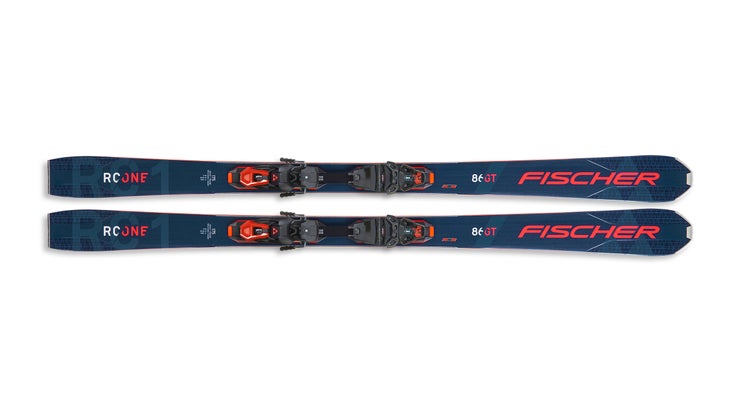
Fischer RC One 86 GT ( $999)
Dimensions: 130/86/116
In Europe, The RC One is an all mountain ski. In the US, it’s a fat carving ski. Either way, its racy graphics are spot on. With its wood and metal layup, relatively short 16-meter turn radius, and wide tip and tail, the RC One is best suited to carving on groomed snow. Forget what you think you know about skinny skis outperforming this width on hardpack (outside of a racecourse). With tip rocker to ease initiation and a hourglass shape that wants to pull you through each turn, the 86 flows seamlessly on boilerplate. Plus, the wide platform makes the ski less nervous (you can make more mistakes), and it cuts through soft surface snow to engage with the base for a powered up carve. Look here if you come from a technical skiing background and like to put your skis on edge and arc, on trail and off. If you already own a set of fat skis, the RC One will build out a quiver.
Gripe: It’s not as easy to pivot or smear as most of the skis reviewed here.
Like: That said, for a carving ski it’s incredibly user-friendly. “You can break them from a carved turn on hardpack with very little effort,” said a tester. “And you can get them arcing at all speeds.”

Kästle MX83 ($1,199)
Dimensions: 126/83/112
Some people like to arc medium to long radius turns at high speed all day. The MX83 is built for exactly that style of skiing. It’s as stable and confidence inspiring as the Enforcer and Stormrider here, but it offers a dynamic carve on hardpack. The performance comes from the build. Two sheets of titanal back a poplar and beech wood core with most of the denser beech positioned underfoot for added power. Vertical sidewalls round it out. And what does that get you? “Holy hell—velocity.” said a tester. “This Kästle is powered up when you want it to be, but you can dump speed and sluff turn it too. My top pick for GS cruising.” Even better, the MX83 doesn’t need to be driven at eye-watering speeds to come to life. The flex is welcoming and the tip dives into mid-range turns on low angled runs. As with the Stöckli in the all-mountain frontside category, you pay more for the best materials and craftsmanship in skiing. The payoff in this case is durability. Some of our testers have skied their Kästles for years with no notable drop-off in performance. “There’s no arguing that a beech core sandwiched by metal and equipped with high-end base materials and edges lasts longer,” said a tester. “And you can feel those materials as you ski.”
Gripe: They like to make medium to large turn shapes, but small turns require dynamic input.
Like: Look here if the word “cruising” means something to you.
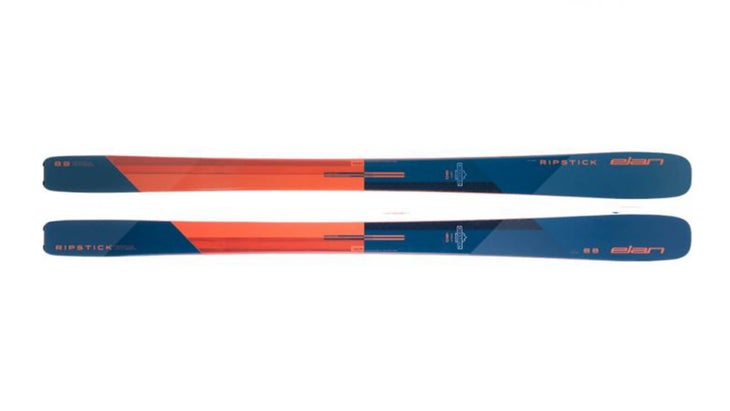
Elan Ripstick 88 ($750)
Dimensions: 130/88/105
Only two all-mountain frontside skis without alloy sheeting survived the hardpack of this year’s test hill to earn inclusion here. The Ripstick 88 is one of them. It excelled off the groomed snow. “Quick, nimble, and forgiving off-trail,” said a tester. “If I was going out to ski bumps, chutes, and soft corduroy all day, this would be my top pick.” Meanwhile, they still performed shockingly well on white ice. The inside edges of these dedicated left and right skis are reinforced with carbon for a boost in torsional strength, which creates tons of edgehold. When you’re skiing edge to edge, the Ripstick 88s don’t wander or waiver. And they hold on at the apex of the turn too, thanks to carbon tubes embedded in the core that act like metal, keeping the ski contouring the snowpack as opposed to chattering out. “Excellent control and energy return in such a lightweight ski,” said a tester. “They’re so nimble and deft that on soft groomers I felt like I was saving energy.” Off-trail, it’s easily the quickest ski we tested, making it well suited to bumps and exploration in soft or shallow snow.
Gripe: At high speeds on hard and chattery snow, there was some minor tip flutter.
Like: “When the snow softened up, the Ripsticks ripped,” said a tester. “On good snow they have a silky ride quality that’s damp, but nowhere near dead.”
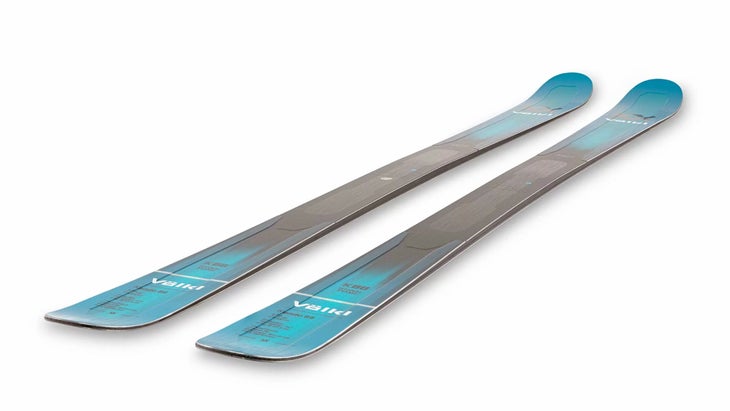
Völkl Kendo 88 ($775)
Dimensions: 129/88/111
This German brand took a different approach to the metal or no metal debate—it went with both. Instead of two full sheets of titanal, a perimeter frame of the alloy adds torsional power for edging and rebound, while strategic cutaways shave weight. Add in some carbon in the tip for smoothness, and the Kendo 88 is one of the most innovative layups in skiing. The goal is a ski that’s stable on hardpack, but loose and light enough for off-trail slashing in soft snow. It actually works. The Kendo is nimble and surfy off-trail, but stout on edge. “Super crisp feel on hard snow,” said a tester. “The torsional power and edgehold match anything in the test.” Our testers also praised the Kendo for its precision. “It feels like you can turn it on a snowflake,” said one. “The initial turn shape is gradual, but the pull underfoot makes you feel like you’re on rails,” said another. Our final take? The Kendo excels at moderate speeds on all groomed snow and is plenty deft enough for occasional forays into bumps and narrows.
Gripe: Völkl’s titanal frame skis have a glassy feel that seems to transmit high frequency vibration. That can be disconcerting—but does not affect performance.
Like: “The energy return from turn to turn is classic Völkl. Skis this lively make groomer days a blast.”
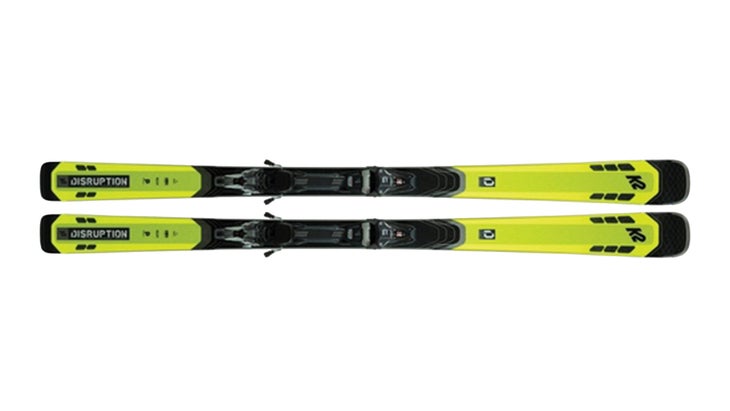
K2 Disruption 82Ti ($1,000)
Dimensions: 125/82/111
Another chubby carving ski, the Disruption 82Ti proves that K2 is back in the game after a long period of disappointing results. “Tons of energy through the entire turn and it seems to contour the snowpack exceptionally well,” said a tester. “It just refused to chatter even though we were skiing on marbles on top of formica.” Credit for the damp and stable ride goes to the usual suspects: a full aspen wood core backed by two sheets of titanal with laser cuts to save weight. But the magic comes from the two chevron-shaped patches of carbon fiber that sit below the upper layer of titanal and allow the inner layers to move against each other as you flex the ski. This is called shearing. Skis that don’t shear well deliver blocky rides. But get it right, and you wind up with a ski that flexes naturally and that a wide range of body shapes and ability levels can pilot. That’s the Disruption 82Ti. You can carve big turns at high speeds and feel like you’re cruising.
Gripe: A few of our testers wanted to see a touch more pop in small and medium range turns. But if you love a damp ride, the Disruption is a Cadillac.
Like: The flat tail and the torsion from the metal serves as a booster when you want to accelerate during a big sweeper turn.
Women’s All Mountain Frontside Skis
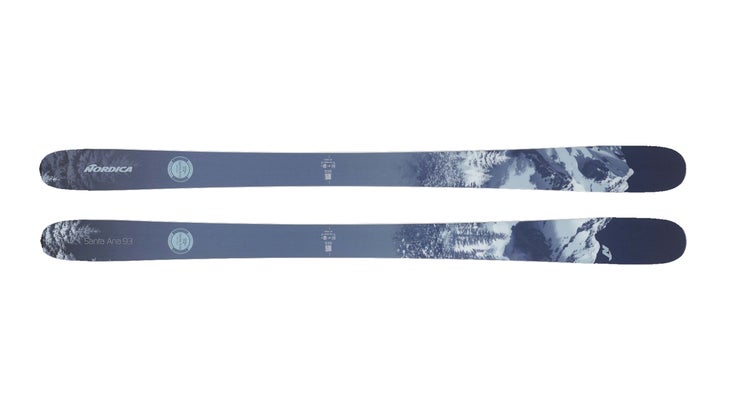
Nordica Santa Ana 93 ($750)
Dimensions: 126.5/93/114.5
Nordica positions the Santa Ana 93 as an equal parts on-trail/off-trail ski for expert women. Our team of expert women skiers agreed. A few key words on the test cards: strong, predictable, versatile, powerful, stable, responsive, aggressive, carveable. Given that feedback, it makes sense that the 93 led the class for its stability and carving rankings. But it’s also an easy ski to smear and pivot when conditions demand. This versatility comes from the balance of footprint and build. There’s just enough rocker to ease turn initiation and offer a touch of float in soft snow, and a full wood core topped by layers of carbon and judiciously laser-cut titanal (designers pull the material back from the edges) adds torsional strength (for edging) and longitudinal stability (for hauling ass). A middle-distance 16-meter turn radius (in the 172 cm length) makes it adept at transitioning from short swing turns to big arcs. “It makes a range of turn shapes, but it just loves big beautiful arcs,” said a tester. “The 93 rewards aggressive skiing, but it doesn’t punish you for getting lazy.”
Gripe: Our testers thought some lighter weight advanced skiers could struggle to handle the Santa Ana 93.
Like: For anyone that wants to advance all aspects of their skiing, the 93 is an ultra versatile tool. “It’s a model that 80 percent of strong skiers should be on 80 percent of the time,” said a tester.
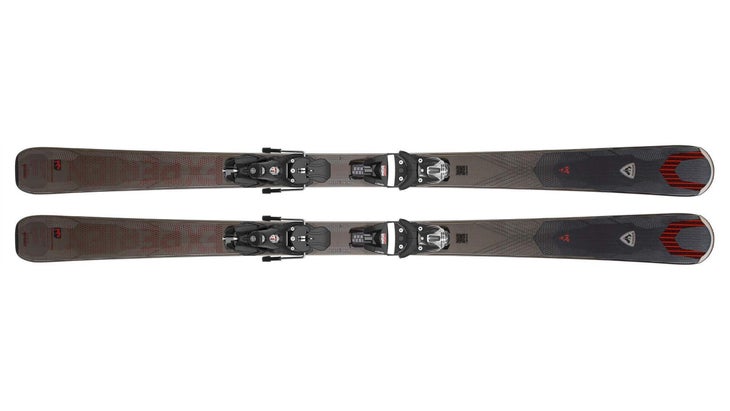
Rossignol Experience 86 ($700)
Dimensions: 132/86/120
If the Santa Ana 93 is all about big sweeping turns, the Rossignol Experience 86 is all about short swing and medium range carves. “Whee!” said a tester. “What a fun little number. It’s full of energy and loves to dive down the fall line from edge to edge.” That about sums up this 86-millimeter carving ski with just enough rocker for some off-trail exploration. But we’ll extrapolate. When Rossignol went to reenvision their strong frontside-focused Experience line, the goal was to boost all mountain versatility while retaining dynamic carving properties. In this version of the 86, that meant replacing the two sheets of titanal with basalt, an igneous rock that acts like a metal and is capable of quelling vibration. Then Rossignol focused its efforts on balancing the deep flex, torsional rigidity (firm but not overbearing), and rocker (just enough in this width) to let the ski transition from groomers to bumps to chalky alpine snow without getting nervous or hooky. Add all that to a 12- to 14-meter radius ski and the result is a fall line dynamo for short swing turns.
Gripe: There’s a touch of chatter at high speeds.
Like: “This ski is so intuitive that an intermediate could learn to carve on it, and an expert could elevate their technical skiing. Makes groomer skiing fun.”
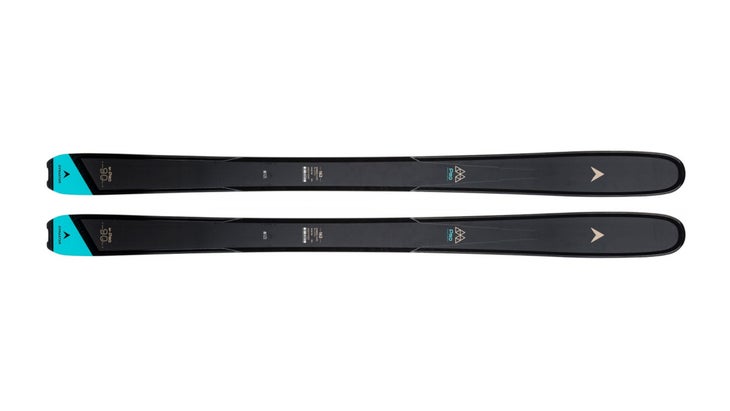
Dynastar M-Pro 90 W ($700)
Dimensions: 120/90/1010
In an age where ski shapes and materials are growing more similar, the M-Pro line from Dynastar stands apart. The skis have a feel all their own, thanks to the core construction. Instead of going with full wood, Dynastar incorporated a hybrid core of wood and polyurethane. And that PU changes everything. First, it saves weight so that Dynastar can place a layer of strategically cut titanal in the ski for stability without heft. Second, PU is naturally supple, which allows the ski to better contour the snowpack for a silky ride. “On edge, you never feel like the ski is chattering, which means the edges are getting more bite,” said a tester. “That really boosts confidence.” Off-trail, that lightweight feel, plus tip and tail rocker, let you slink the 90 through bumps and tight places with very little effort. The width makes it nimble, and when the snow isn’t too deep, that makes it versatile. “Arcs nice round turns on groomers, but turns into a fall-line all mountain ski when you explore,” said a tester. At our test we were skiing on death cookies on top of frozen snot. In those conditions we want as much wood and metal as you can throw at us. The 90 is best suited to soft corduroy.
Gripe: Wanders a bit at high speeds on the hardest of snow.
Like: “They ski mellow when you want them to, but you can get aggressive too,” said a tester.
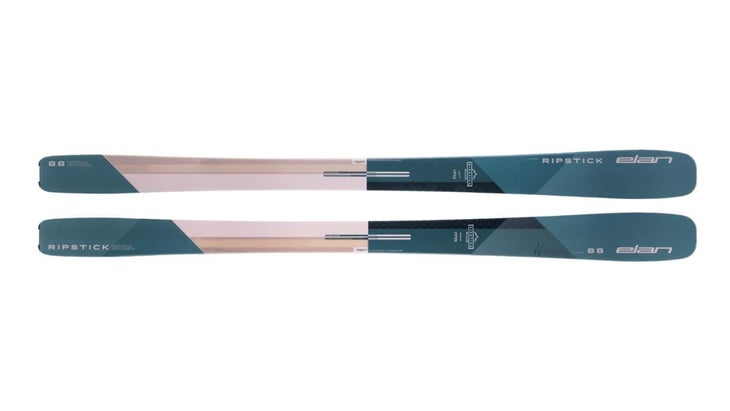
Elan Ripstick 88 W ($700)
Dimensions: 130/88/105
Elan says that the Ripstick 88 W is “wide enough, strong enough, and bold enough to handle whatever the mountains dish out.” As such, the brand asserts that the 88 is a gateway ski for skiers looking to expand their skiing world from frontside groomers to back bowls and hike-to terrain. Our test team agreed. Thanks to its proprietary “Amphibio” design—dedicated left and right skis with more rocker on the outside edges and more effective contact with the inside edges—the 88-millimeter Ripstick is loose and forgiving off trail in all conditions up to boot-deep powder or breakable crud. But take the 88 off trail on windbuff, alpine chalk, or corn and it slinks around terrain seeking the fall line like running water. “It’s nearly impossible to catch an outside edge on these skis,” said a tester. “The performance is top-end, but it’s approachable for most skiers.” Back on trail, those elongated inside edges distribute your weight better, making for a confident edge set despite the fact that this ski has no metal. An extra strip of carbon over the inside edges makes for still more torsional strength and pop.
Gripe: Our testers would have liked a little less rocker since, realistically, this ski will be skied 70 percent of the time on groomers.
Like: “You can carve. You can smear. You can slarve,” said a tester. “There’s crazy versatility here.”
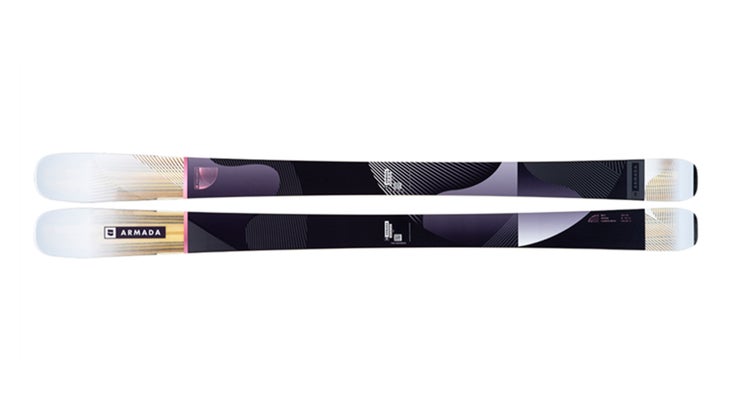
Armada Reliance 88 Carbon ($700)
Dimensions: 130/88/111
Last year Armada expanded its worldview with a line of unisex directional all-mountain skis called Declivity. This year, the new women’s specific Reliance line comes to the fore. Directional skis—as opposed to center-mounted twin tips—represent a big departure for a brand with such strong free-skiing roots. But a closer look reveals that this line is in keeping with the Armada ethos. Yes, you ski them from tip to tail and lay the skis over on edge, but there’s enough rocker and weight savings here for a playful ride when the mood hits. “Great edge grip in an arced turn, but you can shut them down and transition to pivot and smear turns, too,” said a tester. “There’s both latent power and latent playfulness that you can tap into.” That versatility rests in part with Armada’s dedication to rocker. Here, there’s more than enough for groomer skiing, and plenty for adventure. But the construction is just as key. In the 88 Carbon, Armada incorporated stringers of carbon fiber to reinforce the wood core. The fiber gives the ski some extra torsional rigidity and pop. The progressive flex (soft in the tip and tail but incrementally stiffer the harder you push against the belly) is approachable for advanced skiers just getting a feel for their carve.
Gripe: Because there’s no extra metal in it, the 88 got a touch nervous at high speeds on hard snow.
Like: “Super maneuverable off-trail,” said a tester, “but holds a steady carve back on. I’d ski it off trail 65 percent of the time.”

Kästle MX83 ($1,199)
Dimensions: 126/83/112
Skis don’t care about gender: Our male testers ran this same ski in the unisex category and had much the same feedback as our women’s crew. And almost all of that feedback was positive. “Smooth flexing and easy to turn, but stable as all hell at top speeds too,” said a tester. “For the do-it-all groomed-snow skier, the MX83 is a marvel.” There are no cutting edge materials here. What you get is a poplar and beech core backed by fiberglass and metal—the essence of ski construction for half a century. The innovations all have to do with how those simple materials work together. With the 83, the inner layers shear as they’re supposed to, allowing for a consistent and predictable flex. The sweet spot is big and intuitive—it’s hard to be too far forward or too far back—which lets you settle in and push your limits as opposed to fighting to flex the ski. So who is the ideal customer? Someone who spends 80 percent of their time on groomed snow at cruising speeds, but loves to mix up the turn shape, too.
Gripe: Because it’s a unisex ski, getting the length correct is vital. Go too long and it might be too stiff.
Like: “I was expecting it to be unforgiving with a flex built for heavyweights,” said a tester, “but that’s old thinking. Any advanced to expert skier can pilot it.”
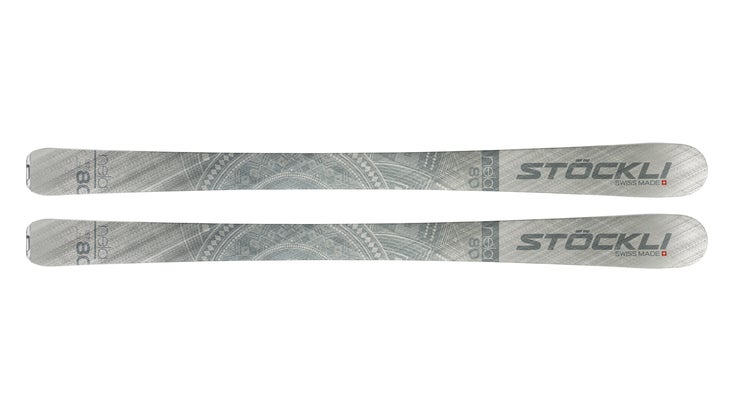
Stöckl Nela 80 ($949)
Dimensions: 121/80/106
Our women testers fell in love with this ripping frontside ski. “This Nela just wants to move!” said a tester. “Lightning quick from edge to edge when you want it to be, but it makes big sweeping turns too. It hugs the snow and never wavers, even though it’s not heavy. It just makes you want to link turns all day long.” The secret sauce is in the construction. Stöckli has a reputation for building unforgiving skis, but that baggage is close to 20 years old now. The Nela has more welcoming features built into it than any women’s specific ski. The core profile is specially milled to offer a deep flex. The layers of fiberglass offer 25 percent weight savings over traditional fiber. Even the edges are specially formulated to save weight thanks to reduced “keys” or tabs that attach the edges inside the ski. Ultimately, though, the ski makers only saved weight in some areas so that they could add performance in others. In the Nela, that means two sheets of titanal—the uppermost layer of which serves as the topsheet. The build delivers a unique Stöckli feel. “Damp and confidence inspiring at high speeds. Easy to turn and forgiving at slow speeds,” said a tester.
Gripe: At 80-millimeters underfoot, this Nela is not built for more than a few inches of powder.
Like: Because it’s narrow, it’s easier to tip on edge.

Fischer RC One 86GT ($999)
Dimensions: 130/86/116
Here’s another unisex ski that Fischer submitted to the unisex and women’s specific tests, and it turns out that its two sheets of titanal, wide waist, and race-bred core worked just as well for the women as it did for the guys. (The only difference was the test lengths.) “Glued to the snow!” said a tester that arcs fast turns. “Super damp and performs best at speed, but a strong skier can get it to make a range of turn shapes.” At the risk of being redundant, the carving acumen comes from the traditional build (wood and metal) and a deep side cut that pulls you through the entire turn from tip to tail. But like any good ski that nailed the flex both longitudinally and torsionally, the pilot gets to decide which turn shape to make. Really get after it and you’ll be cranking 12-meter turns. Ride it out a bit more and you’re at 18-meters. As the graphics suggest, this ski wants to be on packed snow 80 percent of the time. The bonus is that, because of the ample width, it’s easy to engage the edges through soft surface snow and into the firm stuff below.
Gripe: We don’t really have one! Just take heed: to the Europeans this is an all mountain ski. but to North Americans it’s a fat pure frontside ski
Like: It looks intimidatingly racy, but you can scrub speed on a whim. It’s a forgiving carver.
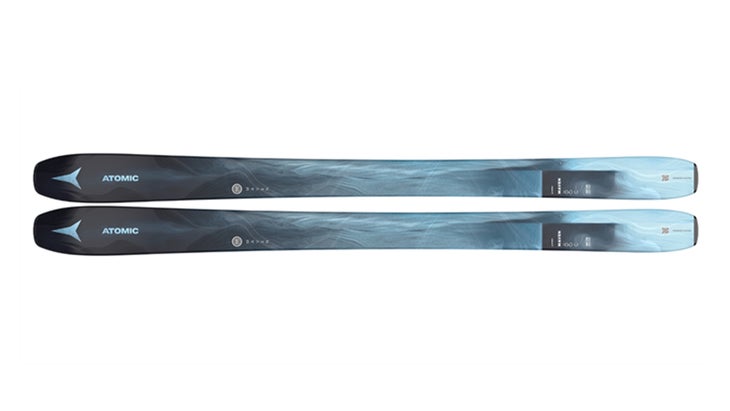
Atomic Maven 86 C ($600)
Dimensions: 121.5/87/105
Most of the skis we test are designed for advanced to expert skiers. That’s based on the premise that an expert can rail a ski that an advanced skier can smear around. Our tests have validated that idea over recent years. The brand new Maven is a bit of a departure. Here, a beginner skier can learn how to put the ski up on edge and start feeling the carve, while an advanced skier can push the ski to its limits. (The thinking is that a true expert woman would opt for the fatter Maven 93 or buy the unisex Atomic Maverick with some metal in it.) Each ski weighs just 1,450 grams. “It’s a lightweight ski for sure,” said a tester, “but it makes a crisp, round arc that’s really easy to get the feel for. The flex is progressive without being daunting. And the on edge stability is top notch.”
Gripe: It’s the nature of a ski built for advanced skiers, but at high speeds this ski wanders a bit.
Like: “The ability to make long and short turns and dump speed when things get dicey is a huge plus for advancing skiers,” said our women’s test director, who taught skiing for years. “The Maven 86 C hits the mark.”
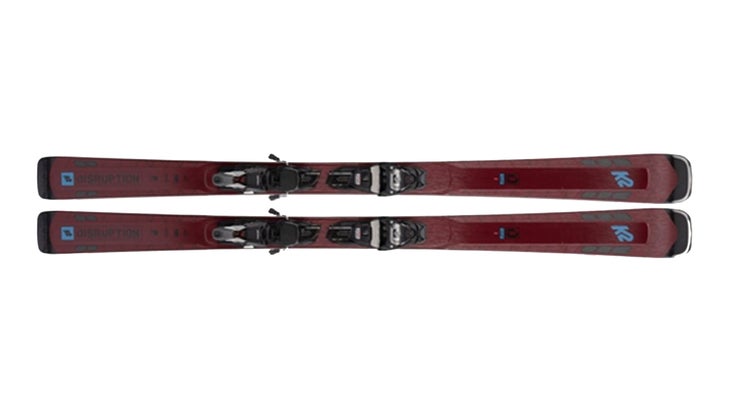
K2 Disruption 81Ti Alliance ($950)
Dimensions: 124/81/110
The sister ski to the Disruption 82Ti, the Alliance shares a lot of similarities with its sibling. That list includes two patches of carbon fiber beneath the titanal in the tip and tail to enhance internal shearing. Here again, a laser cut sheet of titanal tapers forward and behind the bindings for added stability. Beyond that, the highlight is a dense aspen wood core. How did it run on the test hill? It’s closest competitor in our test is the Fischer 86GT, but with the Alliance, the focus is on a damp ride, high-speed stability, and a very predictable turn shape. “Roar!” said a tester. “Holds like a honey badger on hard snow, but it’s super easy to turn at all speeds. There’s a giant sweet spot here. High-speed cruising types will love it.” Look here if you tend to avoid short swing turns in the fall line, but love big sweeping arcs. We’d ski it 85 percent of the time on groomed snow or smooth off-piste surfaces.
Gripe: As much fun as it is to cruise on, it could use just a bit more spunk for fall line skiing.
Like: K2 once made a name for itself by building smooth and consistent skis that performed for the bulk of the market. That’s the Disruption.
Source link

